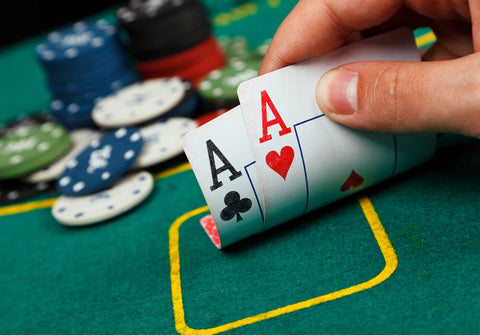1-800-792-7872
sales@chipsandgames.com
1-800-792-7872
sales@chipsandgames.com

Summary: This blog offers a practical guide to playing Texas Hold'Em, highlighting rules, the best hands, and the significance of poker chips.
Main Points:
Texas Hold’Em is probably the most common variety of poker. Aside from the cards themselves, poker chips are the most important component of the game.
So, how do you play Texas Hold’Em? What are some of the best and worst hands in Texas Hold’Em? How many chips do you start with in Texas Hold’Em?
We uncover the answers to these Texas Hold’Em questions below…
Texas Hold’Em is a community card game in which players are dealt two private cards (hole cards) from a standard 52-card deck. Players then use those two private cards in combination with five community cards placed face-up on the table.
The goal is, of course, to achieve the best possible hand and win the pot that’s accumulated as players bet during each game.
How do you play Texas Hold’Em? The basic structure of an individual hand of Texas Hold’Em is as follows:
The five best Texas Hold’Em hands and for most poker games are, as Card Player shares in a reference guide:
Check out our full list of poker hand rankings to learn more.
The worst hand in Texas Hold’Em is a 2 and a 7 of different suits as your hole cards. This is the lowest-value card combination.
Winning chips (and therefore money) from other players by having the best hand or convincing others to fold their hands is the name of the game. Therefore, the number of chips you use is extremely important!
So, how many poker chips do you start with in Texas Hold’Em? That depends on several factors. Let’s explore this answer in greater detail now.
Usually, Texas Hold’Em players choose between two types of home games: cash games and tournaments. The type of game you choose will determine just how many chips you start with.
In cash games, players receive chips depending on how much money they use to buy in. In tournaments, the buy-in is standardized. That means every player receives the same number of chips.
That’s not all, though. You must ensure that you give each player enough chips so they’re not constantly making change from the dealer or from other players, as Home Poker Tourney notes.
In practice, this usually means that the standard Texas Hold’Em chip count per player falls somewhere between 30-50 chips. But in some games, players can have around 100 chips.
The distribution of dollar values in chips given is important, too. In simple terms, you want players to have more chips rather than less. $10,000 in chips of a high dollar value provides a player with far fewer chips than $10,000 in chips of a low dollar value.
Make sure that, proportionally speaking, you’re giving players more low-value chips than high-value chips. A 4-3-2-1 ratio of chips to begin a game is a good place to start.
When playing Texas Hold’Em with five colors, the standard chip values are as follows:

We hope this has proven to be helpful when determining how many chips you need to start your next game of Texas Hold’Em!
Want to learn more about all things Poker-related? Keep up with our blog!
If you’re in need of good quality poker chips, Chips and Games has an incredible variety of poker chip types and styles! We invite you to shop our poker chip collections now.